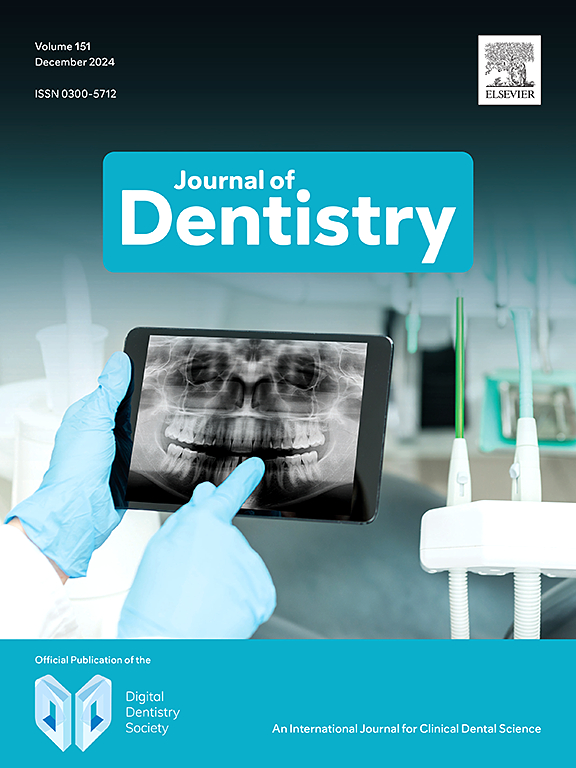Ion-releasing resin composites prevent demineralization around restorations in an in-vitro biofilm model
IF 4.8
2区 医学
Q1 DENTISTRY, ORAL SURGERY & MEDICINE
引用次数: 0
Abstract
Objective
This study aimed to evaluate the effectiveness of two ion-releasing, resin-based composites (RBCs), ACTIVA BioACTIVE-Restorative (BIO1) and ACTIVA Presto (BIO2), in preventing demineralization around restorations.
Methods
Class I and II cavities were prepared on bovine (n = 4) and human teeth (n = 8) and restored with BIO1, BIO2, a conventional composite (RBC, Filtek Supreme XTE), and a resin-modified glass ionomer cement (RMGIC, Ionolux). Following restorations (class I, n= 16/material; class II, n= 8/material), the specimens were exposed to Streptococcus mutans biofilm in a continuous-flow bioreactor over two weeks. Micro-computed tomography (micro-CT) assessed demineralization depths at restoration margins, and supernatant pH changes were measured after a 24-h acidic challenge. Statistical analyses included one and two-way ANOVA and Tukey's test (p < 0.05).
Results
On enamel surfaces, RMGIC showed no demineralization, followed by BIO1 (≈50 μm), BIO2 (≈125 μm), and RBC (≈150 μm). No difference between human or bovine enamel was observed. In dentin, RMGIC showed the least demineralization (≈190 μm), followed by BIO1 (≈230 μm), BIO2 (≈280 μm), and RBC (≈400 μm). pH buffering was highest in RMGIC (+ 0.24 pH), while BIO1, BIO2, and RBC showed similar buffering capacities (∼ +0.1 pH). Gaps were found at several interfaces for BIO1 and RMGIC.
Conclusions
Ion-releasing RBCs varied in effectiveness for reducing demineralization of surrounding tissues, with limited pH buffering capacity. RMGIC exhibited better performance. Gaps between cavity walls and BIO1/RMGIC raised concerns about long-term adhesion.
Clinical significance
ACTIVA BioACTIVE Restorative (BIO1) and ACTIVA Presto (BIO2) resin-based composites promoted slight inhibition of demineralization in an in-vitro biofilm model, suggesting that further modifications in their chemical composition are necessary.
求助全文
约1分钟内获得全文
求助全文
来源期刊

Journal of dentistry
医学-牙科与口腔外科
CiteScore
7.30
自引率
11.40%
发文量
349
审稿时长
35 days
期刊介绍:
The Journal of Dentistry has an open access mirror journal The Journal of Dentistry: X, sharing the same aims and scope, editorial team, submission system and rigorous peer review.
The Journal of Dentistry is the leading international dental journal within the field of Restorative Dentistry. Placing an emphasis on publishing novel and high-quality research papers, the Journal aims to influence the practice of dentistry at clinician, research, industry and policy-maker level on an international basis.
Topics covered include the management of dental disease, periodontology, endodontology, operative dentistry, fixed and removable prosthodontics, dental biomaterials science, long-term clinical trials including epidemiology and oral health, technology transfer of new scientific instrumentation or procedures, as well as clinically relevant oral biology and translational research.
The Journal of Dentistry will publish original scientific research papers including short communications. It is also interested in publishing review articles and leaders in themed areas which will be linked to new scientific research. Conference proceedings are also welcome and expressions of interest should be communicated to the Editor.
 求助内容:
求助内容: 应助结果提醒方式:
应助结果提醒方式:


